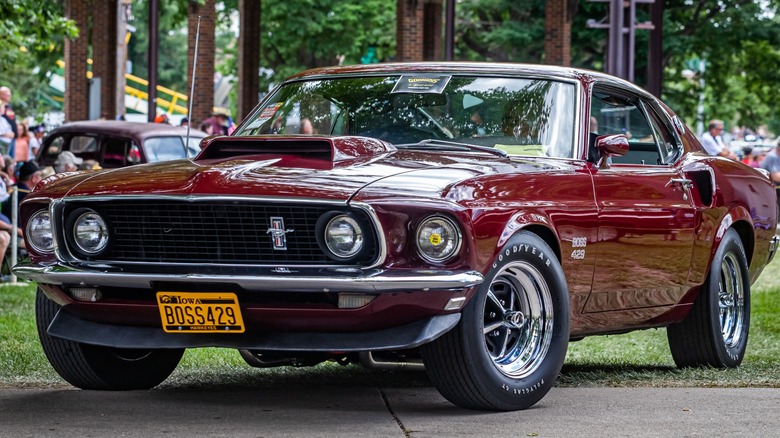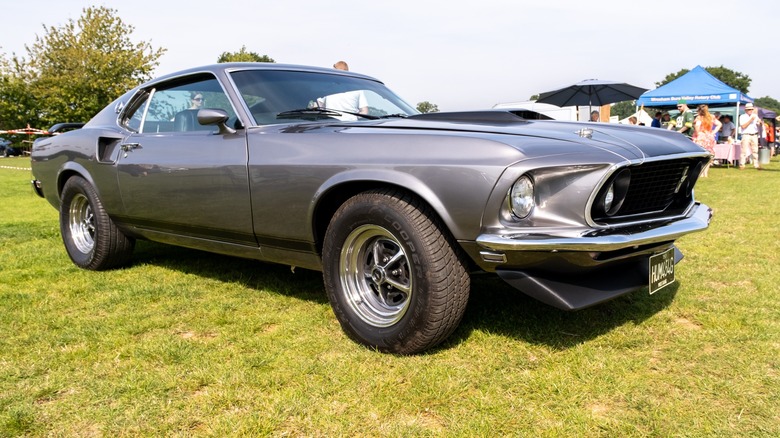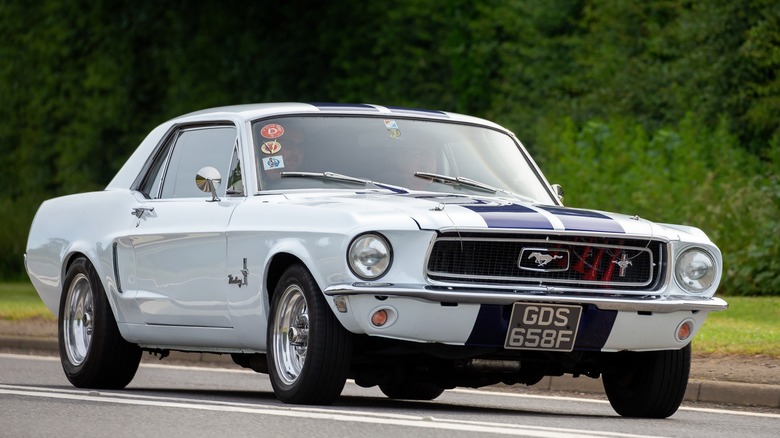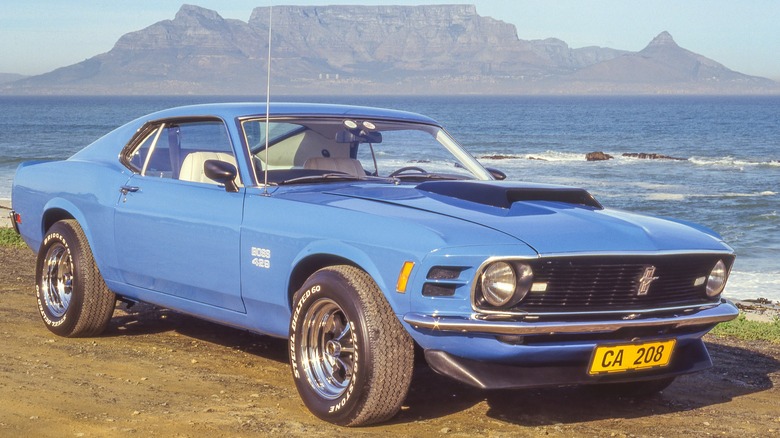All About The Engines That Powered The 1969 Ford Mustang
Ford Mustangs from the late 1960s are far more than just cars. They're movie stars (like the famous Mustang from "Gone in 60 Seconds"), timepieces, collector's items, and overall, they're outright icons. When most folks think of a Mustang, though, they also think of V8 power. Generally, it's pretty safe to assume a classic Mustang has a small block V8 under the hood. However, some folks might be in the dark about just how many engine options these Mustangs had when they were new. This is especially true of the later 1960s models.
Enter the 1969 Mustang. The '69 is nearly the final shout from the first-generation Mustang. Though the 1970 model year was also a first-gen, 1970 is also the year Ford debuted the second-gen Mustang for the incoming 1971 model year. It was also the end of massive power big block V8s courtesy of the inbound emissions restrictions and the 1970s oil crisis. They weren't all big blocks, though. In fact, the 1969 Mustang probably has far more factory engine options than you'd think!
The Forgotten Six-Cylinder
Like we said above, when you think of a Mustang, you typically think of a V8. This is especially true with classic Mustangs. However, the six-cylinder powerplant was always an option, and the 1969 Mustang was no exception.
The entry-level 1969 Ford Mustang engine was a humble 4.1-liter inline six. What's interesting is that Ford marketed this base-level engine using metric units. While all the V8 options displayed their displacement in cubic inches, 1969 Mustang documents display the six-cylinder offering in liters. However, they do specify that it's 250 cubic inches in parenthesis.
At any rate, the "Thriftpower" 4.1-liter inline-six made a lowly 155 horsepower. Likely, this engine wasn't at the top of the sales food chain. Interestingly, though, Ford did offer a fuel-economy-focused variant of the 1969 Mustang with this engine called the Mustang E, a letter designation it would use again over 50 years later on its Mustang Mach-E electric vehicle. They had high-stall torque converters and extremely low gearing to maximize fuel economy. However, Ford only produced about 50 of them.
Small Block Offerings
"Mustang" and "302" go together like bread and butter. With that in mind, it goes without saying that the legendary Windsor 302 V8 was offered for the 1969 model year. However, what should be said is that it saw a revision from the 1968 variant that led to a bit of a bump in horsepower. At 220 horsepower, the entry-level V8 Mustang was packing quite a punch for the era. Of course, that wasn't quite enough for some people. On top of that, Ford had to keep up with the engine offerings coming out of Chevrolet for the Camaro. So, it only goes up from here.
1969 was the first year the Ford Mustang was offered with the equally legendary 351 Windsor. In the Mustang, it was available with 250 horsepower or 290 horsepower, depending on the tuning setup and car options. While 290 horsepower was pretty potent for the time, Mustang enthusiasts will know that this isn't where the lineup stops, either.
Big Blocks, Cobra Jets, and Ram-Air
First up on the Ford big block roster found in the 1969 Mustang is the 390 cubic-inch "FE" engine. It was certainly no slouch! With 320 horsepower on tap, one can safely assume it made for a great time behind the wheel. However, the real show-stopper was even more potent than that.
Enter the 428 cubic-inch Cobra Jet big block V8. Ford advertised these massive engines as having 335 horsepower. However, the story goes that the power was actually around 410. To keep that in perspective, that's only about 75 horsepower shy of the modern Coyote V8 in the 2024 Ford Mustang GT. It was available with or without a "Ram-Air" intake system and a functioning hood scoop. Either way, the power output was the same. However, Mustangs were ordered with optional 3.91 or 4.30 gear ratios, and a 428 got beefier connecting rods, a stronger crankshaft, and an engine oil cooler to keep them reliable on a drag strip. However, these "Drag Pack" cars weren't available with AC because of the oil cooler.
Finally, the Boss 429. You probably associate the word "Hemi" with Dodge. However, the Boss 429 V8 engine also used hemi heads, known as such for the hemispherical combustion chambers. Ford built the Boss 429 Mustangs to homologate the 429 engine for NASCAR racing. It's extremely unique because of its hemi heads, center-mounted spark plugs, and forged steel crankshaft. In production format, they made 375 horsepower.



